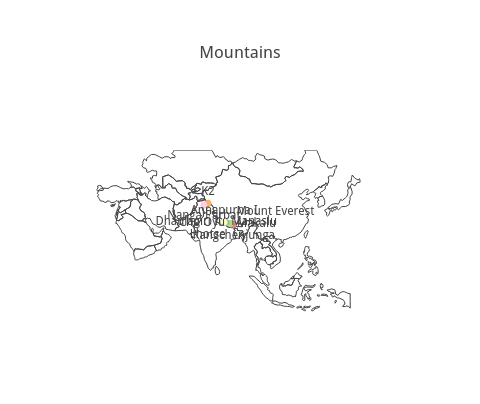NAME
Chart::Plotly::Trace::Scattergeo - The data visualized as scatter point or lines on a geographic map is provided either by longitude/latitude pairs in `lon` and `lat` respectively or by geographic location IDs or names in `locations`.
VERSION
version 0.020
SYNOPSIS
use Chart::Plotly;
use Chart::Plotly::Plot;
use Chart::Plotly::Trace::Scattergeo;
use Chart::Plotly::Trace::Scattergeo::Marker;
my $scattergeo = Chart::Plotly::Trace::Scattergeo->new(
mode => 'markers+text',
text => [ 'Mount Everest', 'K2', 'Kangchenjunga', 'Lhotse', 'Makalu', 'Cho Oyu',
'Dhaulagiri I', 'Manaslu', 'Nanga Parbat', 'Annapurna I'
],
lon => [ 86.9252777778, 76.5133333333, 88.1475, 86.9330555556, 87.0888888889, 86.6608333333,
83.4930555556, 84.5597222222, 74.5891666667, 83.8202777778
],
lat => [ 27.9880555556, 35.8813888889, 27.7033333333, 27.9616666667, 27.8897222222, 28.0941666667,
28.6966666667, 28.55, 35.2372222222, 28.5955555556
],
name => "Highest mountains
https://en.wikipedia.org/wiki/List_of_highest_mountains_on_Earth",
textposition => [ 'top right',
'top center',
'bottom center',
'bottom left',
'right',
'left',
'left',
'right',
'bottom center',
'top center'
],
marker => Chart::Plotly::Trace::Scattergeo::Marker->new(
size => 7,
color => [
'#bebada', '#fdb462', '#fb8072', '#d9d9d9', '#bc80bd', '#b3de69',
'#8dd3c7', '#80b1d3', '#fccde5', '#ffffb3'
]
)
);
my $plot = Chart::Plotly::Plot->new( traces => [$scattergeo],
layout => { title => 'Mountains',
geo => { scope => 'asia', }
}
);
Chart::Plotly::show_plot($plot);DESCRIPTION
The data visualized as scatter point or lines on a geographic map is provided either by longitude/latitude pairs in `lon` and `lat` respectively or by geographic location IDs or names in `locations`.
Screenshot of the above example:

This file has been autogenerated from the official plotly.js source.
If you like Plotly, please support them: https://plot.ly/ Open source announcement: https://plot.ly/javascript/open-source-announcement/
Full reference: https://plot.ly/javascript/reference/#scattergeo
DISCLAIMER
This is an unofficial Plotly Perl module. Currently I'm not affiliated in any way with Plotly. But I think plotly.js is a great library and I want to use it with perl.
METHODS
TO_JSON
Serialize the trace to JSON. This method should be called only by JSON serializer.
type
Trace type.
ATTRIBUTES
connectgaps
Determines whether or not gaps (i.e. {nan} or missing values) in the provided data arrays are connected.
customdata
Assigns extra data each datum. This may be useful when listening to hover, click and selection events. Note that, *scatter* traces also appends customdata items in the markers DOM elements
customdatasrc
Sets the source reference on plot.ly for customdata .
fill
Sets the area to fill with a solid color. Use with `fillcolor` if not *none*. *toself* connects the endpoints of the trace (or each segment of the trace if it has gaps) into a closed shape.
fillcolor
Sets the fill color. Defaults to a half-transparent variant of the line color, marker color, or marker line color, whichever is available.
geo
Sets a reference between this trace's geospatial coordinates and a geographic map. If *geo* (the default value), the geospatial coordinates refer to `layout.geo`. If *geo2*, the geospatial coordinates refer to `layout.geo2`, and so on.
hoverinfo
Determines which trace information appear on hover. If `none` or `skip` are set, no information is displayed upon hovering. But, if `none` is set, click and hover events are still fired.
hoverinfosrc
Sets the source reference on plot.ly for hoverinfo .
hoverlabel
hovertext
Sets hover text elements associated with each (lon,lat) pair or item in `locations`. If a single string, the same string appears over all the data points. If an array of string, the items are mapped in order to the this trace's (lon,lat) or `locations` coordinates. To be seen, trace `hoverinfo` must contain a *text* flag.
hovertextsrc
Sets the source reference on plot.ly for hovertext .
ids
Assigns id labels to each datum. These ids for object constancy of data points during animation. Should be an array of strings, not numbers or any other type.
idssrc
Sets the source reference on plot.ly for ids .
lat
Sets the latitude coordinates (in degrees North).
latsrc
Sets the source reference on plot.ly for lat .
legendgroup
Sets the legend group for this trace. Traces part of the same legend group hide/show at the same time when toggling legend items.
line
locationmode
Determines the set of locations used to match entries in `locations` to regions on the map.
locations
Sets the coordinates via location IDs or names. Coordinates correspond to the centroid of each location given. See `locationmode` for more info.
locationssrc
Sets the source reference on plot.ly for locations .
lon
Sets the longitude coordinates (in degrees East).
lonsrc
Sets the source reference on plot.ly for lon .
marker
mode
Determines the drawing mode for this scatter trace. If the provided `mode` includes *text* then the `text` elements appear at the coordinates. Otherwise, the `text` elements appear on hover. If there are less than 20 points, then the default is *lines+markers*. Otherwise, *lines*.
name
Sets the trace name. The trace name appear as the legend item and on hover.
opacity
Sets the opacity of the trace.
selected
selectedpoints
Array containing integer indices of selected points. Has an effect only for traces that support selections. Note that an empty array means an empty selection where the `unselected` are turned on for all points, whereas, any other non-array values means no selection all where the `selected` and `unselected` styles have no effect.
showlegend
Determines whether or not an item corresponding to this trace is shown in the legend.
stream
text
Sets text elements associated with each (lon,lat) pair or item in `locations`. If a single string, the same string appears over all the data points. If an array of string, the items are mapped in order to the this trace's (lon,lat) or `locations` coordinates. If trace `hoverinfo` contains a *text* flag and *hovertext* is not set, these elements will be seen in the hover labels.
textfont
textposition
Sets the positions of the `text` elements with respects to the (x,y) coordinates.
textpositionsrc
Sets the source reference on plot.ly for textposition .
textsrc
Sets the source reference on plot.ly for text .
transforms
uid
unselected
visible
Determines whether or not this trace is visible. If *legendonly*, the trace is not drawn, but can appear as a legend item (provided that the legend itself is visible).
AUTHOR
Pablo Rodríguez González <pablo.rodriguez.gonzalez@gmail.com>
COPYRIGHT AND LICENSE
This software is Copyright (c) 2018 by Pablo Rodríguez González.
This is free software, licensed under:
The MIT (X11) License